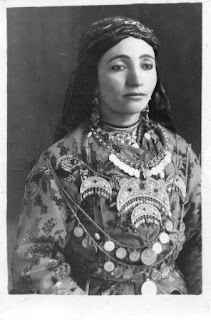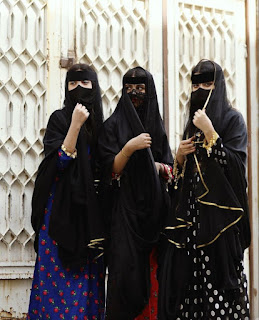West Asian traditional clothing part 2
KUWAIT
In Kuwait, the traditional dress for men is called a "Dishdasha" or "Thobe". It is a long, loose-fitting garment that covers the body from the neck to the ankles, typically made of cotton or wool. The dishdasha has long sleeves, and is usually white, although other colors are also worn. The headwear worn with the dishdasha is a white headscarf called a "Ghutra", which is held in place by a black cord called an "Agal".
For women, the traditional dress is called an "Abaya", which is a long, loose-fitting, black garment that covers the body from head to toe. The abaya is often worn over western-style clothing and is sometimes embellished with embroidery, sequins, or other decorative elements. Some women may also wear a headscarf, called a "Sheila", with their abaya.
LEBANON
Lebanese traditional clothing for men includes a long white shirt, called a thobe, paired with loose-fitting pants and a headscarf. Women often wear traditional embroidered dresses called tarbush or m shattah, along with a headscarf and jewelry. These traditional garments are typically worn during special occasions and cultural events.
a traditional head covering worn by women in Lebanon. It is a large, cone-shaped hat that is often decorated with gold or silver thread and embellished with beads, sequins, and other decorative elements. The tarbush is typically worn as part of a traditional Lebanese outfit and is used to protect the face from the sun and to indicate a woman's marital status. In the past, it was also a symbol of wealth and status.
OMANThe traditional clothing for men in Oman is the "dishdasha," a long white robe that is worn with a headscarf (called a "mussar") and a curved dagger (called a "khanjar"). Women in Oman wear the "abaya," a black, full-length cloak, and a headscarf. In both cases, the attire is typically completed with sandals. Wearing a traditional dress is seen as a symbol of cultural heritage and respect, and it is common for Omanis to wear traditional dress on special occasions and events. In modern times, however, many Omanis also wear western-style clothing in their daily lives.
PALESTINE
Traditional Palestinian clothing is characterized by its intricate embroidery and vibrant colors and reflects the region's rich cultural heritage.
For women, traditional garments include the "thobe," a long, loose dress, and the "headscarf," a veil worn over the head and shoulders. Another popular item is the "jilbab," a long coat-like garment that is worn over the thobe.
For men, traditional clothing includes the "kaffiyeh," a headscarf worn as a symbol of Palestinian nationalism, and the "thobe," a long, loose shirt worn with pants.
These garments are often handmade and passed down from generation to generation, preserving the cultural identity of Palestinians.
QATAR
In Qatar, fashion for women has evolved over time and now encompasses a blend of traditional and modern styles. Although the traditional dress, the abaya, is still widely worn, many women in Qatar also incorporate western clothing into their wardrobes, such as dresses, skirts, and pants. Designer boutiques, luxury brands, and high-end fashion shops are becoming increasingly popular in Qatar, and women are experimenting with different styles, colors, and fabrics. Additionally, there are several fashion events and exhibitions held in Qatar that showcase local international fashion talent.
 |
| Image Source |
 |
| Image Source |
 |
| Image Source |
 |
| Image Source |
SAUDI ARABIA
the traditional dress is the "abaya," a black, loose-fitting, full-length cloak, often worn with a headscarf. In some regions, women may also wear a face veil known as a "niqab." The traditional dress of Saudi Arabia reflects the country's conservative cultural values and is still widely worn, especially in more rural or conservative areas.
In recent years, fashion in Saudi Arabia has become more diverse, with women incorporating both traditional and modern styles into their wardrobes. The traditional abaya is still widely worn but now comes in a variety of styles, colors, and fabrics, including designs with embellishments and embroidery. Women in Saudi Arabia are also wearing more western-style clothing, such as dresses, skirts, and pants, often incorporating these pieces into their outfits along with the abaya. Designer boutiques, luxury brands, and high-end fashion shops are increasingly popular in the country, and fashion events and exhibitions are becoming more prevalent, showcasing local and international fashion talent. Overall, fashion in Saudi Arabia is becoming more varied and expressive, reflecting the changing attitudes and evolving cultural landscape of the country.
 |
| Image Source |
 |
| Image Source |
 |
| Image Source |
 |
| Image Source |
 |
| Image Source |
SYRIA
Traditional Syrian fashion is characterized by colorful and intricate embroidery, as well as flowing fabrics and loose silhouettes. Common garments include thobes (long, loose-fitting shirts), hijab headscarves, and flowing dresses called jallabiyas. These traditional styles have been influenced by various cultures, including Ottoman Turkish, Persian, and Bedouin, and reflect the country's rich history and diverse heritage. Some regional variations can be found across the country, particularly in terms of the type of embroidery used, the choice of colors, and the overall style of the garments.
 |
| Image Source |
 |
| Image Source |
 |
| Image Source |
 |
| Image Source |
 |
| Image Source |
 |
| Image Source |
 |
| Image Source |
TURKEY
Traditional Turkish clothing is a blend of Ottoman and Central Asian styles. For men, it includes the fez (a type of hat), baggy pants called "şalvar," and a long, loose robe called a "kaftan." For women, traditional clothing consists of long, flowing dresses, often covered by a veil or headscarf, and adorned with intricate embroidery and other embellishments. These traditional garments are still worn in rural areas and for special occasions in modern-day Turkey.
 |
| Image Source |
 |
| Image Source |
 |
| Image Source |
 |
| Image Source |
 |
| Image Source |
 |
| Image Source |
UNITED ARAB EMIRATES
Traditional clothing in the United Arab Emirates (UAE) is known for its simplicity and elegance. For men, the traditional attire is the "dishdasha," a white, ankle-length gown with long sleeves, worn with a headscarf called a "gutra." Women typically wear the "abaya," a long, black, loose-fitting gown that covers the entire body, along with a headscarf. In both cases, the attire is often accessorized with gold jewelry. Traditional clothing is still widely worn in the UAE, especially in rural areas and during special occasions.
 |
| Image Source |
 |
| Image Source |
 |
| Image Source |
 |
| Image Source |
 |
| Image Source |
 |
| Image Source |
YEMEN
Traditional clothing in Yemen is a reflection of the country's rich cultural heritage and history. For men, the traditional attire includes a long, loose-fitting gown called a "thobe," worn with a headscarf called a "shemma." Women wear long, flowing dresses called "fouta," often decorated with intricate embroidery and beadwork, and covered by a veil or headscarf. In both cases, the attire is often accented with jewelry, such as necklaces, bracelets, and earrings. Despite the influence of Western fashion in cities, traditional clothing is still worn by many Yemenis, especially in rural areas and for special events.
 |
| Image Source |
 |
| Image Source |
 |
| Image Source |
 |
| Image Source |
 |
| Image Source |
 |
| Image Source |





























































0 Comments